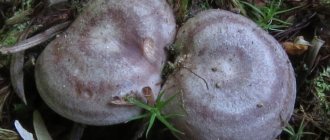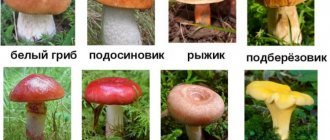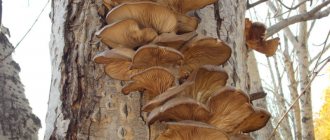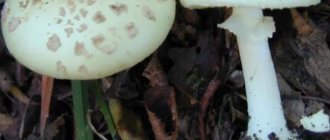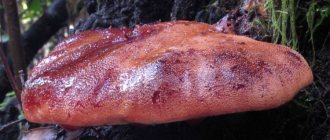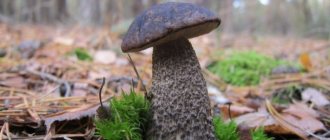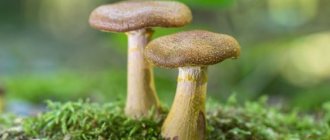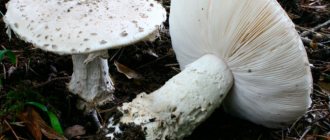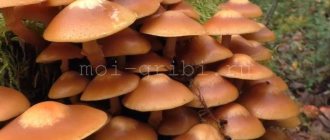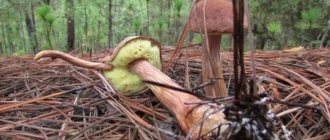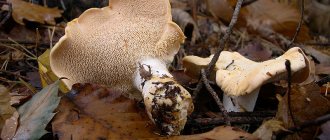Types of these mushrooms, appearance
Serushka and greenfinch mushrooms (see photo and description below) are very similar in appearance, but greenfinch mushrooms are not recommended for consumption. Most often, the caps of seruha look mixed with gray, however, they are also found with a slightly pinkish or purple tint. These mushrooms are also called bitter mushrooms, gray hollow mushrooms, budworts, lilac milk mushrooms, and gray mushrooms. The size of the caps of these mushrooms can be approximately 4-12 cm in diameter, depending on the age of the mushroom itself. Younger mushrooms have a convex cap, while older mushrooms have a funnel-shaped cap.
The mushrooms also have not very smooth edges, which are slightly curved inward. The stem of the mushroom also has a gray tint and is 4-10 cm long. The pulp of the bitter mushroom has a pleasant fruity aroma.
Serushka belongs to the row mushrooms, among which are known:
- The row is silver.
- The row is sulfur-yellow.
- The row is grayish-lilac.
- The row is crowded.
- The row is fused.
- The row is dry.
- Tiger row.
- Poplar row.
- The row is decorated.
- Violet row.
- The row is purple.
- The row is scaly.
- The row is humpbacked.
- The row is dirty.
Use in cooking
Serushka is considered a conditionally edible mushroom. Before cooking, it must be soaked in clean water for some time. By itself, it has a bitter taste, so it cannot boast of good compatibility with various dishes. However, after soaking, the bitter taste disappears, only a pronounced mushroom aroma remains, so serushka is very often used as part of rowing assortments.
During the cooking process, these mushrooms retain a fairly dense consistency, decrease slightly in size and retain their bright, pleasant color. Most often they are consumed pickled or after pickling. After salting, they taste practically no different from champignon, but are considered much more affordable.
How to salt serushka
First of all, it is necessary to get rid of the characteristic bitterness that is inherent in this type of mushroom. Most of the substances that are responsible for this bitter taste are contained in the juice of the sorrel, so long soaking is necessary to get rid of them. It takes two or three days to completely remove the bitterness, depending on the size and age of the mushrooms.
The water should be clean and cool, it should be changed three or four times a day, replacing it with new water. Most other mushrooms that belong to the milky family, such as milk mushrooms and tremors, are prepared in exactly the same way. Serushka is considered ready for pickling when the caps no longer break when pressed, but simply bend.
As for dishes, the best for pickling, of course, are barrels or other containers made of pure hardwood. However, enamel or glass containers with a wide neck are also quite suitable so that pressure can be installed.
After a long soaking, the serushka can be salted. To do this, you need to place them tightly in a suitable container with the caps down, and then cover them with salt, using about 25 grams of salt for one kilogram of raw materials.
To improve the taste and give it special notes, you can add garlic, a little horseradish, cherry or currant leaves.
During pickling, mushrooms must be under pressure, so large dishes with a wide neck are usually used. If you want to use ordinary jars for pickling, you need to do this: you need to tightly fill the jar with mushrooms, right up to the neck, into which you also need to stuff the leaves, and close the lid on top, applying significant force. Provided that the mushrooms are completely covered with brine, oppression will not be necessary. You can also use the hot method of salting the mushrooms; in this case, they are not soaked, but simply boiled for 20-25 minutes, then the water is drained and the mushrooms are salted. You can store the finished product at a low temperature; a balcony, refrigerator or basement is well suited for this.
Application
In cooking
In cooking, serushka mushrooms (see photo and description of how to prepare them below) are used quite often. Usually these mushrooms are well soaked and salted, however, they can also be eaten boiled by boiling for 15 minutes. Ready-made boiled mushrooms can be added to absolutely any dish, for example, soup, potatoes or even salads. In addition, earrings can be dried, pickled, fried or stewed. Preparing a dish with these mushrooms does not take much time.
In medicine
As mentioned above, earrings can also be used in folk medicine. Decoctions, ointments and various tinctures are prepared from them. Today, these mushrooms are also actively used in the fight against parasites.
Features of preparing edible earrings
To get rid of the bitter-acrid taste, mushrooms should be cleaned and be sure to soak in salt water for 3-4 days.
Note!
However, before drying the fruits, they are not washed, but cleaned with a sponge.
Primary processing
Mushroom processing should begin immediately after harvesting. First of all, they need to be cleared of debris (sand, leaves, twigs, clay). Then use a knife to cut off all the places that have been damaged by insects or rodents, carefully clean off the dirt and remove the cut area on the stem. Clean the lamellar layer located under the cap from debris by washing.
How to pickle at home
You can pickle mushrooms hot or cold.
For hot pickling of fruits you will need the following ingredients:
| Name | Quantity | Measure |
| Mushrooms | 1 | kg |
| Salt | 40-50 | G |
| Spices | – | taste |
| Leaves of cherry, currant, horseradish | 15 | PC. |
Preparation consists of the following steps:
You may be interested in: How do edible talkers differ from false mushrooms? How many days after rain do mushrooms grow? Bitter mushroom: photo and detailed description
- Cleaned and soaked mushrooms must be blanched in salted water for about 10 minutes, periodically skimming off the foam.
- Then rinse them under running water and dry them, throwing them in a colander to get rid of excess liquid.
- Add some salt and spices to the bottom of the pan.
- Then the fruits are laid out with their caps down. The approximate height of the layer is approximately 5-6 cm. Sprinkle each mushroom layer with salt, spices and bay leaf.
- Cover the mushrooms with leaves and place a folded cloth on them. Cover the surface with a wooden circle and press down with pressure.
After 3-4 days, the fruits should be covered with brine. If this does not happen, you need to increase the weight of oppression. Cold salting differs only in that the product does not need to be cooked.
Marinating mushrooms
The preparation of earrings should be divided into two stages: preparation of the fruits themselves and the marinade.
The following products are used for marinating:
| Name | Quantity | Measure |
| Mushrooms | 1 | kg |
| Water | 1 | l |
| Vinegar | 3 | Art. l. |
| Sugar | 1,5 | Art. l. |
| Salt | 3 | Art. l. |
| Spices | – | taste |
First, peeled and soaked mushrooms are boiled in salted water for half an hour, constantly skimming off the foam. A marinade is prepared from water, vinegar, sugar, salt and spices by boiling it for 5 minutes. Mushrooms are placed in sterilized jars, poured with hot marinade and covered with lids.
Serushki are valued by lovers of “silent hunting” for their healthy and unique taste. Mushrooms can be pickled, pickled or dried to enjoy a tasty and healthy dish in winter.
Harm and contraindications
As such, there are no contraindications to the use of serushka, however, the mushroom should be well soaked before use, otherwise it will have an unpleasant aftertaste. Also, with these mushrooms, as with any others, you need to be extremely careful, because if you overeat, it can affect your digestive system.
For people suffering from gastrointestinal problems, it is better to consume sulfur in very small quantities, or avoid them altogether.
Description
The mushroom has a rich gray cap, which is reflected in its name. His other “names”:
- seruha;
- seryanka;
- gray hollow;
- milky gray (gray-lilac);
- sub-tree;
- plantain;
- traveler
This type of delicious mushroom belongs to the genus Mlechnik of the Russula family. Belonging to the genus Mlechnik indicates a specific feature - the presence of milky juice. The mushroom is found in mixed, birch and aspen forests, often near roads and paths in the forest, singly or in small groups.
According to the species description of the gray eel, the color of its cap varies from pink and violet-gray to brown-lead. In all cases, it contains concentric zones that are noticeable in color (darker). During the growth process, the cap is initially convex over its entire area. In a mature specimen, it has the shape of a funnel with a smooth tubercle in the middle. The edges are uneven and drooping. The diameter of the row reaches 10 cm.
Irina Selyutina (Biologist):
Graylings are characterized by a plump small leg, which is not always visible due to the rather large cap. The fungus grows no more than 8 cm in height, but the cap in rainy summers can reach a diameter of 20 cm. Unlike most mushrooms, worms do not damage the earrings, and even if this happens, the cap remains intact - only the bottom of the stem “suffers” . The stem is cylindrical with grooves along its entire length. It is because of the hollow stems of mature specimens that mushroom pickers nicknamed the greyhound “duplyanka”.
The milky juice contains an antibiotic that can fight Staphylococcus aureus and some other types of pathogenic bacteria.
Other features of the appearance of the mushroom:
- The hymenophore plates have a pale, yellowish color. Rarely located. At first glance, it immediately becomes noticeable that they have grown to the leg and it seems as if they are descending. In appearance, the plates may be tortuous.
- The spores are usually yellowish in color.
- The leg is hollow, but only in mature seryanka. The shape of the leg in a growing representative of the species may be slightly swollen or, conversely, narrowed. Usually its thickness does not exceed 2 cm, and its length is 8 cm.
- The dense white pulp has a fruity smell.
- When cut or broken, a very caustic white milky juice is released that does not change color upon contact with air. Interestingly, at the site of damage, the juice forms non-hardening droplets.
How to distinguish edible from inedible
Among all types of rows, half of them are edible and will not cause harm to the body, and half are false ones, which are poisonous. Let's figure out how to distinguish the serushka mushroom (photo) from edible and poisonous.
Poisonous mushrooms include white, sulfur, sulfur-yellow, soap, mouse, tiger and other types of rows. Young white rowers differ in the color of their cap, young ones have a white tint, more mature ones have brown spots. The appearance of the leopard print pattern resembles the fur pattern of a tiger or leopard. The color of the flesh of this mushroom is gray.
Mouse rows are colored gray inside, and the taste is quite unpleasant and burning. Mushrooms with a yellow cap should also not be eaten, since when cut, the mushrooms begin to emit hydrogen sulfide. Soap rows are not hazardous to health, however, after cooking they have a soapy taste and are impossible to eat.
Other names for serushki
The conditionally edible variety is often called by mushroom pickers in different regions of our country:
- sulphur;
- seryanka;
- bitter;
- gray hollow;
- bluish milk mushroom;
- grayish-purple milkweed;
- gray milky;
- sub-tree;
- plantain;
- traveler;
- way.
Such different names emphasize not only the appearance of the fruiting bodies, but also the tendency to form mycorrhizae with certain plant species, as well as the area of distribution.
The nutritional value of bitter mushrooms, as well as their taste characteristics, are determined by the chemical composition of the mushroom pulp.
Preparation and storage
Raw serushka mushrooms should not be stored for too long, so there is no need to stock up on them for future use. If you are going to add mushrooms to any dishes, then it is better to immediately soak and boil them.
You can dry such mushrooms, but not everyone will like their taste, so if you decide to store earrings for yourself, it is better to simply pickle them and preserve them in jars, which can then be stored for quite a long time. A recipe for how to deliciously pickle serushka mushrooms can be found on the Internet.
Where they grow, in what forests and how to collect
Mushrooms are mainly distributed in the northern regions of Russia. They grow in birch groves, deciduous and mixed forests. They can be found in clearings, forest edges and along forest roads. Fruits can grow alone or in whole groups in one place.
You should go on a “quiet hunt” for white salmon from the beginning of July until the end of September. If the year was dry, then the yield of these mushrooms is low.
Spreading
The row can only be found in autumn
Plantain grows in loamy and sandy areas, moist but well-lit. Typically, these mushrooms grow in groups and often inhabit lowland (and not only) birch forests. They are found in areas where melt waters stand for a long time, in ordinary forest edges and clearings. Serushka is found from summer to October inclusive.
Recipe for envelopes made from serushka mushrooms
You can serve ham stuffed with mushrooms on the festive table.
- 0.5 kg of earrings;
- 0.4 kg ham;
- 0.2 kg cheese;
- 2 onions;
- 2 tbsp. l. vegetable oil;
- salt and pepper to taste.
- Finely chop the salted mushrooms and onions. Add salt and pepper and fry.
- Cut the ham into 5x5 cm squares. Place the filling on each piece and wrap it in an envelope. Place them on a baking sheet, sprinkle with grated cheese.
- Bake in the oven at 180˚C for 10 minutes.
You can simply bake the earrings in the oven in sour cream and cheese sauce. Preparation will not take more than 10 minutes.
Beneficial features
In the Middle Ages, serushka was used to treat the stomach and related diseases. It was even included in medicines for cholera and consumption (tuberculosis). The mushroom contains many vitamins and microelements in suitable proportions. They are considered unique.
Seryanka is suitable for dietary nutrition, because it is surprisingly well absorbed by the body and has the right effect on it. It is a wonderful immune stimulant and gastrointestinal support.
The calorie content of serushka per 100 g of mass is 18.5 kcal.
The energy value is (per 100 g):
- proteins: 1.8 g;
- fat: 0.8 g;
- carbohydrates: 1.1 g.
The vitamin composition per 100 g of product is presented:
- choline – 17.3 mg;
- betaine – 9.4 mg;
- nicotinic acid – 3.607 mg;
- vitamin C – 2.1 mg;
- pantothenic acid – 1.497 mg;
- riboflavin – 0.402 mg;
- vitamin B6 – 0.104 mg;
- thiamine – 0.081 mg;
- folic acid – 17 mcg;
- vitamin K1 – 1 mcg;
- group D – 0.4 mcg;
- alpha tocopherol (E) – 0.01 mg;
- vitamin B12 – 0.04 mcg.
The mineral composition (per 100 g) also speaks volumes:
- potassium – 318 mg;
- phosphorus – 86 mg;
- selenium – 9.3 mg;
- magnesium – 9 mg;
- calcium – 3 mg;
- zinc – 0.52 mg;
- iron – 0.5 mg;
- copper – 0.318 mg;
- manganese – 0.047 mg.
This mushroom has a positive effect on the brain, blood vessels and even the removal of salts from the body.
Recipes for dishes with serushka
Adding serushka to dishes gives them a delicate aroma, unusual taste and beneficial properties. The mushroom goes well with nuts, meat, beans, cabbage, potatoes, gherkins, tomatoes, corn, onions and garlic. Before including putik in dishes, it is recommended to pre-soak it in water for 3 days. This will eliminate excessive bitterness and pungent odor.
The following recipes for serushka are distinguished, which are distinguished by their rich taste and low calorie content:
- Pickled serushki. A kilogram of mushrooms is boiled from the moment of boiling for about 20 minutes. It is necessary to constantly remove the foam. When the earrings settle to the bottom and the liquid becomes clear, you can remove the brine from the heat. After it has cooled, they begin to pour into sterile clean jars. Earrings are marinated for about two months in a cool and dark place.
- Pike-perch with serushki and cheese sauce. A whole pike perch is cleaned, the entrails are removed, the head and fins are cut off, and then the backbone and large bones are removed. Then the fillet is salted, seasoned with spices, sprinkled with lemon juice, coriander is added and placed in the refrigerator. 2 large onions are peeled, cut into thin rings and thrown into a frying pan generously greased with vegetable oil. Serushki are washed with water and not subjected to any heat treatment. In a separate container combine 3 tablespoons of cream, 60 grams of grated hard cheese and mushroom broth. The baking dish is covered with foil, and pike perch strewn with mushrooms and onions is placed on top. Then the fish is poured with cheese sauce, covered with foil and placed in the oven for half an hour at a temperature of 190 degrees. The finished dish is seasoned with chopped herbs and cut into portions.
- Potato and mushroom casserole. 2 onions are peeled, cut into thin rings and thrown into a heated and oiled frying pan. 3 potatoes are peeled and cut into slices. 250 grams of earrings are thoroughly washed and cut into cubes. The baking dish is covered with foil, then the potatoes are laid out, sprinkled with spices and coriander, and salted. The next layer is mushrooms with fried onions. Then potatoes again. After this, the dish is poured with 200 ml of cream and placed in the oven for half an hour at a temperature of 170-180 degrees.
- Mushroom caviar. Dried earrings are soaked for several hours in filtered water. Meanwhile, 1-2 onions are peeled, chopped into slices and fried in vegetable oil until golden brown. Garlic passed through a press, a sprig of thyme, black pepper and coriander are added to it. When the ingredients have cooled, they are passed through a meat grinder along with the mushrooms. The finished dish can be decorated with parsley leaves.
- Meat with serushkas and cream sauce. One onion is peeled, chopped and fried in sunflower oil until golden brown. Then it is removed and 300 grams of chopped chicken fillet is added. Fry until half cooked. Next, all the ingredients are combined and simmered over low heat. Then add a tablespoon of flour and 100 grams of chopped earrings, hold for another 2 minutes. After this, pour in a glass of milk, chopped parsley with dill, salt and pepper to taste. Turn off the heat, add 60 grams of butter, cover with a lid and let it brew for 10-15 minutes.
- Serushka salad. 5 large tomatoes, washed and cut into slices. 100 grams of earrings are thoroughly washed to remove any remaining dirt and chopped into cubes. One medium onion is peeled, cut into thin rings and added to the rest of the ingredients. Pass 3 cloves of garlic, 4 tablespoons of mayonnaise through a press and mix thoroughly. Then salt, pepper and sprinkle with chopped parsley.
We invite you to familiarize yourself with the Conclusion
Most often, earrings are salted and pickled, but they can also be eaten as an independent snack. They resemble porcini mushrooms in taste and beneficial properties.
Hot method of salting for the winter
- Clean the mushrooms from dirt, rinse thoroughly and soak for four days, changing the water regularly.
- Soaked mushrooms are boiled in salted water for half an hour.
- For every liter of boiled mushrooms, add two tablespoons of salt.
- If desired, you can add finely chopped garlic and dill seeds to the mushrooms.
- Place the mushrooms in sterilized jars, cover with plastic lids and store in the refrigerator or cellar.
Mushrooms can be consumed one and a half months after pickling.
Features of growing mushrooms on stumps
The types of mushrooms that grow on stumps can be grown at home, creating conditions for them that are as close to natural as possible. The best option is to grow tree mushrooms in your summer cottage.
For stumps, you need to use sections of wood from deciduous trees, or use real stumps left over from recently cut down trees.
Most often, oyster mushrooms are grown on the site. To ensure their growth and normal development, you need to take poplar, birch, and maple wood. Coniferous species should not be used, as they contain a large amount of caustic resins that can destroy the mycelium.
If fresh wood is used, there is no need to soak or moisten it first. If the stumps are old, then they need to be kept in a container with cold water for several days.
After the logs are ready, you can add the mycelium of the selected type of tree fungus. To do this, you can make holes in the hemp in a checkerboard pattern. Their depth should not be more than 6 cm, and their diameter should not be 1 cm.
Mycelium should be poured into these holes. After this, they need to be covered with moss or closed with adhesive tape.
Logs with mycelium must be placed in the basement. They should be folded into a pyramid shape and covered with burlap.
To plant stumps, you should choose a shaded place. You need to dig a hole no more than 15 cm deep, line the bottom with wet leaves or sawdust. You need to place a stump in the hole. The distance between each of them should be at least 35 cm. The stumps should be watered if necessary.
Another way is to grow tree mushrooms in a trench. You can do it this way:
- Dig a trench up to 15 cm deep.
- Pour dry pearl barley onto the bottom, which will provide the mycelium with good nutrition.
- Place disinfected mycelium on top. Each stump should contain 300 g of seed.
- Place the moistened stumps on the mycelium and lightly sprinkle with soil.
After planting tree mushrooms, you need to water the soil
This must be done carefully, since excess moisture does not benefit the growing mushrooms. It is best to use a spray bottle for watering
Watering should be done during dry periods.
For the winter, the mushroom plantation should be covered with a layer of straw or foliage. It is necessary to cover the stumps with material so that the mushrooms do not freeze.
Criteria for distinguishing edible from inedible tree mushrooms
Poisonous mushrooms are most often found on trees. The differences lie in a number of criteria:
- Large hat. Many poisonous mushrooms have a large cap surface diameter;
- The flesh is colored. Most often, if the wood fungus has red or orange flesh, it is inedible.
- Complete or partial absence of a leg. Many poisonous mushrooms are represented either by only a cap or an extremely small stalk.
These universal criteria will help you choose an edible mushroom. However, if there is even the slightest doubt about the identity of the tree mushroom, you need to throw it away.
Pre-cleaning of greenfinches in the forest
Collecting green rows is a rather labor-intensive and slow process. During their growing season (September - early November), you can no longer find other mushrooms in the forest, which means finding greenfinches will not be difficult. But before you put another mushroom in the basket, it must be thoroughly cleaned of soil and sand.
Greenfinches grow quite deep in the soil, so you will have to clean the mushroom a little when collecting. You won't take the soil home, will you?
How to pre-clean greenfinch right in the forest
The above manipulations will help get rid of the bulk of the sand and soil that are stuck to the mushroom. Now you can put it in a basket or bucket without fear that dried sand will fall onto the lower greens and then have to be washed out.
If you do not want to clean the mushroom in the forest, then it should be cut 1–2 cm below the cap
Remember that the mushrooms will need to be cleaned of sand immediately upon arriving home. Collect medium to large sized greenfinches and make sure they are not too old.
Small greenfinches have caps slightly curled towards the stem, and the plates are small, so it is very difficult to clean them
Milky mushroom. Mushrooms Milky
Lactarius (lat. Lactarius) is a genus of lamellar mushrooms of the Russulaceae family (lat. Russulaceae). Synonyms: Gruzd, Gladysh.
The Latin name of the genus means “milk”, “milk-giving”.
They live in forests and forest clearings, in tundras, forest-tundras, and less often in swamps and meadows.
Economic importance In Europe, the overwhelming number of species of the genus Lactarius are considered inedible or even poisonous. In Russia, many species are considered edible, usually in salted or pickled form.
About 400 species are known, distributed throughout the globe. About 50 species are found in the countries of the former USSR.
Types of Milkies:
Conditionally edible
Real milk mushroom
Lat:
Lactarius resimus
Synonyms: White breast, Raw breast, Wet breast, Right breast.
90888
20
Characteristics:
- Information: with milky juice
- Group: plate
- Plates: fused
- Laminae: slightly descending
- Color: red-brown
55257
34
Black milk mushroom
Lat:
Lactarius necator
Synonyms: Olive-black milk mushroom, Nigella, Chernysh, Black hollow, Gypsy, Black spruce milk mushroom, Olive-brown milk mushroom, Agaricus necator, Lactarius turpis, Agaricus plumbeus, Lactarius plumbeus.
50024
62
Aspen milkweed (Poplar milkweed)
Lat:
Lactarius controversus
Synonyms: Poplar breast, White milkweed, Agaricus controversus.
44812
7
Violin
Lat:
Lactarius vellereus
Synonyms: Felt breast, Skripun, Skripukha, Euphorbia, Milk scraper, Rusk.
Characteristics:
- Information: with milky juice
- Group: plate
- Laminae: slightly descending
- Records: white
- Records: rare
- Pulp: turns yellow when cut
- Pulp: dense
- Information: large
- Taste: hot
- Legs: white
- Legs: whitish
40902
21
Oak milkweed
Lat:
Lactarius quietus
Synonyms: Neutral milkweed, Oak milkweed, Calm milkweed, Poddubnik, Podoreshnik.
Headings: M, Edible mushrooms
29106
8
Milkman
Lat:
Lactarius volumemus
Synonyms: Milkweed, Euphorbia, Galorrheus volemus, Lactifluus volemus, Amanita lactiflua, Lactarius lactifluus, Lactifluus oedematopus, Lactarius oedematopus, Lactarius ichoratus, Galorrheus ichoratus, Lactifluus ichoratus, Lactarius testaceus, The best milkweed, by the way the official Russian-language mycological name ), Podoreshnik, Belarusian – Padareshnik).
Similar mushrooms and false dangerous doubles
In terms of the structure of the fruiting body, the rows (including inedible and poisonous ones) are similar to each other. Characteristic features are not always easy to identify, since mushrooms tend to change externally over time: in color, cap shape, stem structure.
Serushka can easily be confused with the following mushrooms:
- poisonous pointed rower (Tricholoma virgatum). Young mushrooms have a conical cap, which becomes flat as they grow, thinner than that of an edible mushroom. Characterized by a small tubercle in the center. Color - ash gray or earthy. The leg is thin. The plates are greyish. The pulp tastes hot.
- Soap mushroom (Tricholoma saponaceum) is an inedible mushroom with an olive-green or olive-brown cap. The color is uniform, without diverging stripes. It is quite easy to distinguish - there is a strong smell of laundry soap.
- The distinguished row (Tricholoma sejunctum), also known as the isolated row, has the status of conditionally edible. It has an unpleasant odor and bitter taste of the pulp. Requires long-term heat treatment before use.
The green row has its dangerous counterparts. First of all, this is the sulfur or sulfur-yellow row (Tricholoma sulphureum). The poisonous mushroom is smaller in size, “frail” in structure: thin stem, sparsely spaced plates. The pulp is yellow, has an unpleasant odor and bitter taste. Trying to describe this aroma, some mushroom pickers compare it with tar, others with hydrogen sulfide.
Of the inedible mushrooms, the greenfinch is similar to the sultry row (Tricholoma aestuans) and the already mentioned isolated row. You can find out what the serushka and greenfinch mushrooms look like by carefully examining the photo.
